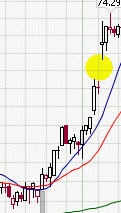Technical analysis chart formations provide high profit return potential when using Candlestick signals. Candlestick analysis involves the visual identification of patterns that have been recognized for hundreds the years. Identifying technical analysis chart formations that have produced a statistical probability result makes for an excellent trading format.
One of the most powerful technical analysis chart formations is the gap. Gaps occurring at different locations in a trend have different meanings. Taking advantage of what they reveal becomes highly profitable. Dissecting the implications of a gap/window makes its appearance easy to understand. Where a gap occurs is important. The ramification they reveal in a chart pattern is an important aspect to Japanese Candlestick analysis. Some traders make a living trading strictly from gap trading.
Gaps (Ku) are called windows (Mado) in Japanese Candlestick analysis. A gap or window is one of the most misunderstood technical messages. It is usually advised by a good percentage of investment advisors to not buy after a gap. The explanation being that it is too dangerous to predict what will happen next. That advice usually comes from somebody that does not know how to use gaps successfully. Gaps reveal powerful high profit trades. Candlestick signals, correlated with the appearance of a gap, provide high-probability profitable trade set-ups. The unique built-in forces, encompassed in the Candlestick signals, and the strength of a move revealed by the existence of a gap, produce powerful trading factors. The knowledge of what this combination of signals reveal will produce consistent and strong profits.
These technical analysis chart formations are not “hidden” secret signals or newly discovered formulas that are just now being exposed to the investment world. These are a combination of widely known but little used investment techniques. Candlestick signals obviously have a statistical basis to them or they would not still be in existence after many centuries. Gaps have very powerful implications. Combining the information of these two elements produces investment strategies that very few investors take the time to exploit.
Consider what a window or gap represents. In a rising market, it illustrates prices opening higher than any of the previous days trading range. What does this mean in reality? During the non-market hours, something made owning a stock, or any other trading entity, tremendously desirable. So desirable that the order imbalance opens the price well above the prior day’s body as well as the high of the previous day’s trading range. As seen in Figure 1, note the space between the high of the previous day and the low of the following day.

Gap Trading Example
Witnessing a gap or window at the beginning of a new trend produces profitable opportunities. Gaps formed at the beginning of the trend reveal that upon the reversal of direction, the buyers have stepped in with a great amount of zeal. A common scenario is witnessing a prolonged downtrend. A Candlestick signal appears; a Doji, Harami, Hammer, or any other signal that would indicate that the investor sentiment is changing. What is required to verify a Candlestick reversal signal at the bottom? More buying the next day! A bullish candle indicates a reversal has occurred. A “gap-up” bullish candle indicates that a reversal has occurred with extraordinary force.
Many investors are apprehensive about buying a stock that has popped up from the previous day’s close. A risky situation! The hesitancy is caused by the percentage move. When most investors are happy with a 10% return annually, it is hard for an investor to commit funds to a position that has moved 12% in one day. Understanding what the gap-up represents eliminates that fear.
A Candlestick investor has been forewarned that the trend is going to change, viewing the Candlestick signal as the alert. A gap-up, illustrating buyer enthusiasm, reveals excessive strength. Use the gap as a strength indicator. The fact that the initial move is substantial should act as an indication that the remaining move of this new trend could be more substantial.
Always keep in mind, the markets do not care what investors fears and perceptions are. A price that has moved dramatically in one day may be cause for fear to enter a trade from most investors. They do not have the knowledge to understand what that strong move illustrates for the future.
Gaps form in many different places and forms. Some are easy to see, some need to be recognized. Utilizing the technical analysis chart formation information provides the capability to be involved with high profit trades. The information provided from the combination of a Candlestick buy signal or sell signal, followed by a gap, reveals an immense amount of information. And being able to analyze the technical analysis chart formation correctly provides an investor with the opportunity to make good consistent profits.
Speak Your Mind